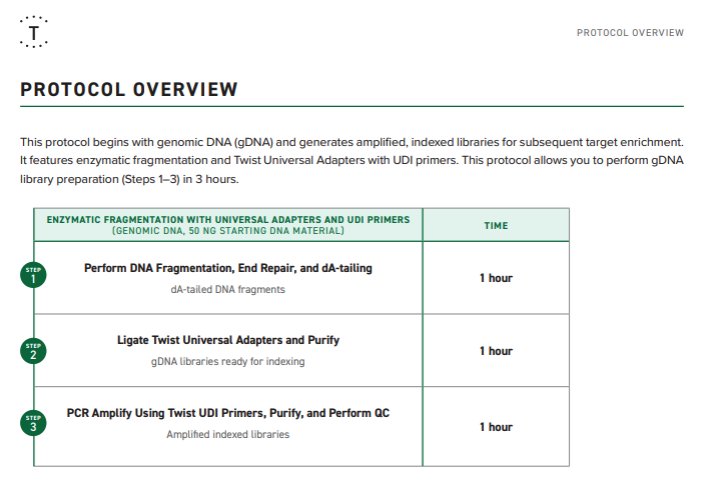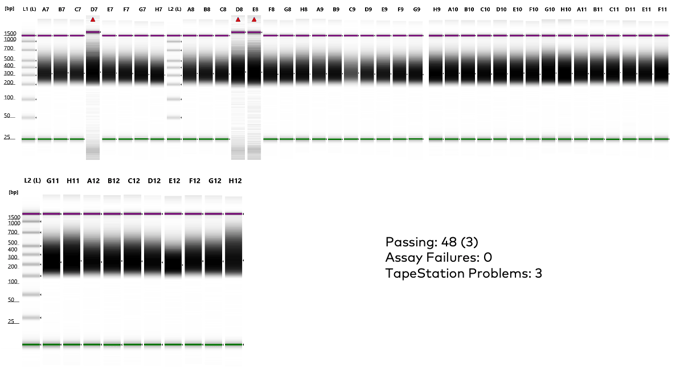DISPENDIX's U.S. Commercial team (Sales and Marketing) meets for an engaging quarterly workshop to develop, plan, and align our customer-facing activities. One key aspect of these workshops involves providing hands-on training for our Outside Sales Representatives (OSRs) on the laboratory techniques and applications that our customers use in their work. This empowers our OSRs to effectively engage with our customers, whether it be through virtual or on-site interactions.
Do you know any non-lab scientists who possess even the most basic laboratory skills, let alone have completed an entire NGS (next-generation sequencing) project from start to finish? In our industry, OSRs typically aren't expected to perform library prep in the lab—until now.
Basic Lab Skills Training
Our NGS expert and lead scientist, Joseph Strycharz, led the Sales team through basic lab training in order to carry out the library prep protocol by TWIST Bioscience. The OSRs first had to get pipette training. Any researcher, PI, RA, or TA that has trained a colleague or student on this topic knows that micropipetting can be difficult to do for several reasons:
- Precision: Micropipettes are used to transfer very small volumes of liquid, most often in the microliter (µL) range. This requires a high degree of precision and accuracy, as even a small user error can have a significant impact on the results of an experiment.
- Technique: Micropipetting requires a specific technique in order to ensure accuracy. This technique includes using the correct pipette tip, positioning the pipette correctly, and depressing the plunger slowly and smoothly.
- Fatigue: Micropipetting can be physically demanding, especially when transferring large numbers of samples. This is because the pipetting action requires repetitive small movements of the hand and arm.
- Environmental factors: Environmental factors such as temperature, both ambient and of the fluid being aspirated, humidity, and air pressure can also affect the accuracy.
Next, the team went through TWIST's library prep protocol, a popular method for preparing genomic DNA (gDNA) libraries using enzymatic gDNA fragmentation and Y-shaped adapters (Fig. 1). The TWIST 96-Plex Library Preparation kit is a purpose-built kit for high-throughput library construction for whole genome sequencing (WGS).

Figure 1. Overview of TWIST Bioscience's library prep protocol.
As with any library prep protocol, TWIST's involves several steps, including DNA fragmentation, adapter ligation, DNA purification, library amplification, library QC, and, of course, high-throughput sequencing.
Another important aspect of library prep is DNA purification, most commonly done using magnetic beads. Bead clean-ups are generally not difficult to perform, but they can be tricky if you are not familiar with the protocol. Here are some common challenges associated with bead-based DNA clean-ups:
- Beads are not fully resuspended before use. One must ensure that they are in a uniform suspension.
- Disturbing the bead pellet. When transferring beads, disturbing the pellet with a pipette tip at the bottom of the tube is a common challenge, especially for novice pipette users.
- Incorrect size tube for your bead volume. The beads may not pellet properly if the microtube is the incorrect size.
- Over-drying the beads. Being careful not to over-dry the beads when removing the supernatant after washing can make resuspension difficult and reduce DNA yields.
Each OSR enthusiastically participated in two library preps across two days. The first day served as a true test of their pipetting skills, as they manually carried out the liquid dispensing and bead-based clean-up processes.
On the second day, they experienced the liquid handling automation benefits of using the I.DOT, an advanced non-contact and tip-free liquid dispenser, which replaced their manual pipetting, as well as the benefit of the G.PURE, a robotic bead-based DNA clean-up device, to perform automated DNA purification.

Figure 2. Semi-automated NGS library prep workflow diagram which includes the I.DOT and G.PURE (DISPENDIX).
The results were remarkable.
Results
Each library was subjected to QC using the TapeStation (Agilent Biotechnol). The first day's sequencing run resulted in 27 libraries passing and 21 failing, resulting in a 43.7% dropout rate (Fig. 3).

Figure 3. TapeStation (Agilent Biotechnologies) results for the DISPENDIX Sales team's first library prep, which included only manual pipetting.
We suspected that the dropout rate occurred because the OSRs, despite their best efforts, had yet to develop the necessary expertise in pipetting. There are are so many factors that one must consider when first learning how to use a pipette. Some specific challenges that can make pipetting difficult include:
- Avoiding air bubbles: Air bubbles can form in the pipette tip and cause inaccurate measurements. It is important to carefully remove any air bubbles before pipetting.
- Preventing cross-contamination: It is important to avoid contaminating the pipette tip and the sample being pipetted. This can be done by using sterile pipette tips and by carefully handling the samples.
- Maintaining accuracy: Micropipettes need to be calibrated regularly to ensure that they are dispensing the correct volume of liquid. It is also important to use the correct pipette tip for the volume of liquid being pipetted.
In the scientific community, precision and accuracy are paramount, thus, mastering the art of pipetting is an essential skill that demands extensive practice from both seasoned lab technicians and those new to the laboratory environment.
The OSRs were determined to achieve 100% success for their second library prep.
The second day's sequencing run resulted in exactly that (Fig. 4). All 48 libraries passed QC.

Figure 4. TapeStation (Agilent Biotechnologies) results for the DISPENDIX Sales team's second library prep, which was a semi-automated protocol that included the I.DOT and G.PURE (DISPENDIX).
Discussion
These data support that the removal of user error with respect to pipetting results in successful, clean libraries (Fig. 4). Manual pipetting can be a laborious and precarious task that poses a risk to the integrity of data. It can even lead to the need for complete re-doing of library preps, which is a costly process.

Figure 4. Overlay comparison of all 48 sample wells from both library preps, manual library prep (left) and semi-automated library prep (right).
With the advent of liquid handling automation, however, researchers have access to a range of benefits that can optimize their workflows, enhance accuracy and precision, and ultimately save costs. By minimizing the need for re-doing library preps due to user error, researchers can avoid the unnecessary expenses and time-consuming processes associated with starting from scratch. The I.DOT ensures that every dispense is precise, eliminating the need for costly reagents and sample wastage. Similarly, the G.PURE ensures that arguably the most critical step of the NGS library preparation workflow is successfully completed with peace of mind.
Accuracy For Every Lab
The I.DOT and G.PURE are revolutionizing liquid handling in the lab by providing unmatched accuracy and precision, regardless of who is working that day. With this advanced non-contact and tip-free liquid dispenser, researchers can say goodbye to the inconsistencies and errors that often arise from manual pipetting.
Gone are the days of worrying about the skill level or experience of the person handling the pipette. The I.DOT and G.PURE ensure that every library prep is precise and accurate, eliminating user error and producing reliable results every time. This not only saves valuable time and resources, but also instills confidence in the data generated from the experiments.
Imagine a lab where even the newest member of the team can confidently perform complex liquid handling tasks with ease and accuracy. With the I.DOT and G.PURE, this is now a reality. Their user-friendly interfaces and intuitive operations make it accessible to researchers–and sales reps–of all skill levels, empowering them to carry out their work with confidence and efficiency.
Get a quote today!
